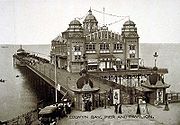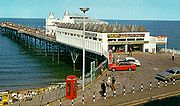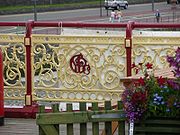
Victoria Pier
Encyclopedia





- For the pier in Kingston upon Hull, see Victoria Pier, Kingston upon Hull
Victoria Pier is a pier
Pier
A pier is a raised structure, including bridge and building supports and walkways, over water, typically supported by widely spread piles or pillars...
in the seaside resort of Colwyn Bay
Colwyn Bay
- Demography :Prior to local government reorganisation on 1 April 1974 Colwyn Bay was a municipal borough with a population of c.25,000, but in 1974 this designation disappeared leaving five separate parishes, known as communities in Wales, of which the one bearing the name Colwyn Bay encompassed...
on the coast of North Wales
North Wales
North Wales is the northernmost unofficial region of Wales. It is bordered to the south by the counties of Ceredigion and Powys in Mid Wales and to the east by the counties of Shropshire in the West Midlands and Cheshire in North West England...
between Rhyl
Rhyl
Rhyl is a seaside resort town and community situated on the north east coast of Wales, in the county of Denbighshire , at the mouth of the River Clwyd . To the west is the suburb of Kinmel Bay, with the resort of Towyn further west, Prestatyn to the east and Rhuddlan to the south...
and Llandudno
Llandudno
Llandudno is a seaside resort and town in Conwy County Borough, Wales. In the 2001 UK census it had a population of 20,090 including that of Penrhyn Bay and Penrhynside, which are within the Llandudno Community...
. It is 750 ft (227m) long.
History
Designed by Maynall & Littlewoods of Manchester, Colwyn Bay's Victoria Pier was one of the later British piers to be built, with construction starting in June 1899 by the Salford firm of William Brown & Sons. Its official opening was on 1 June 1900, when the architect, Mr. Littlewood, handed a golden key to the pier's owners. As first constructed, the pier was just 316 ft (96m) long and 40 ft (12m) wide, comprising a timber promenade deck with seating and railings along its length, and a 2,500 seat 'Moorish' style pavilion. The pavilion was set to the right of the deck, with a walkway allowing access to the pier-head to the left. The pavilion's main entrance was flanked on one side by a flower shop and, on the other, by a coffee lounge and cake shop. Inside, the pavilion boasted a large balcony which extended around three sides of the auditorium and a full orchestra pit.In 1903, the Victoria Pier Company decided to extend the neck to a length of 750 ft (227m) to facilitate outdoor theatrical performances.
A 600 seat 'Bijou' theatre was built at the pier head in 1917 for the purposes of light entertainment. The main Pavilion building was completely destroyed by fire in 1922. The Victoria Pier company suffered serious financial difficulties after the fire. As a result, Colwyn Bay Urban District Council purchased the pier and work began immediately to rebuild the pavilion. In July 1923 the second pavilion was opened, at a cost of £45,000. Unfortunately, disaster struck again on the 16th May 1933, when the second pavilion was destroyed by fire, followed on the 28th July 1933 by a fire that destroyed the Bijou theatre.
Once again, Colwyn Bay Urban District Council set about rebuilding, and the present pavilion was opened on Tuesday, 8 May 1934 at a cost of £16,000, but the Bijou theatre was never rebuilt. Increasing usage of the pier led the council to introduce a twopenny toll (free after 6pm) in 1936, which included the price of a deckchair and listening to the band. The purpose of the toll, said the council, was to prevent 'indiscriminate lounging on the pier'. In the pavilion, Ernest Binns presented 'The Colwyn Follies', with seats at two shillings, one shilling and sixpence.
During the 1950s and 60s, the pier began a period of gentle decline. In 1953, the pavilion's tearoom, which had been a year-round meeting place for 40 years, started closing for the Winter. In 1956, the line up of entertainment in the pavilion was as follows: Monday: Bingo, Tuesday: Wrestling, Wednesday: Amateur Talent Show, Thursday: Old Time Dancing, Friday: Popular Dance, Saturday: Young People's dance. 1958 saw the end of the Summer variety shows in the pavilion. In 1959, the variety shows were replaced by a small orchestra of six musicians; over 20,000 people paid 9 pence each that year to attend the afternoon concerts, with another 10,000 attending in the evenings. By 1961, falling audiences forced the council to reduce the orchestra to three musicians. 1962 saw the council admit defeat for live performances and install pre-recorded orchestral music.
In 1968, ownership of the pier passed from the local council to Entam Leisure, a division of Trust House Forte, for just £59,000. Entam Leisure decided that the pier needed modernisation to prosper. This involved building the Golden Goose Amusements in a large new modern building on the pier neck, the opening of the Golden Fry Restaurant in the old tearooms, and the conversion of the pavilion into the Dixieland Showbar. As part of this work, the ornate Moorish toll booths at the entrance to the pier were removed to create an open aspect to the pier entrance.
During the 1970s, the Dixieland Showbar hosted many live concerts, featuring groups/acts such as Motorhead, The Damned, Siouxie & The Banshees, Elvis Costello, Slade, Budgie, The Specials, Jackie Wilson, Madness, Cockney Rejects.
In 1979, the pier was sold again, this time to Rhyl based leisure operators, Parkers Leisure (Holdings) Ltd. They converted the Dixieland Showbar into CJ's Nightclub and built an extension onto the front of the Golden Goose Amusements, to create a larger entrance/amusements area. 1987 saw the entire seaward end of the pier being closed to the general public, on grounds of safety. In 1991, Parkers Leisure closed down their amusement and disco businesses on the pier. Vandals attacked the pier after the closure, smashed most of the windows in the former Golden Goose Amusements, and broke into the pavilion to set fire to it. In 1993, Colwyn Borough Council gave permission to demolish the pavilion and seaward end of the pier, but the work was never carried out.
Recent history
August 1994 saw new hope for the beleaguered pier, as marine engineer Mike Paxman bought it and stated he intended to restore it to its former glory. Mr. Paxman carried out work to repair the pier's decking and subdivided the former Golden Goose Amusements building into several smaller business, including a bar, cafe, shops and amusements, which opened on April 1, 1996. He also intended to reopen the pavilion as a nightclub but did not have sufficient funding to do so. He eventually put the pier up for sale in 2003 by advertising it on auction site EbayEBay
eBay Inc. is an American internet consumer-to-consumer corporation that manages eBay.com, an online auction and shopping website in which people and businesses buy and sell a broad variety of goods and services worldwide...
but it failed to sell.
On December 11, 2003, the pier was bought by Cambridgeshire businessman Steve Hunt, who sold his house to fund the £100,000 purchase price. He reopened the pier on Saturday 17 January 2004 and announced his intention to gradually restore the decaying structure. He has a particular interest in restoring the pier's Art Deco
Art Deco
Art deco , or deco, is an eclectic artistic and design style that began in Paris in the 1920s and flourished internationally throughout the 1930s, into the World War II era. The style influenced all areas of design, including architecture and interior design, industrial design, fashion and...
Pavilion, built in 1933.
At present (2008), the entrance building houses a fishing tackle shop, cafe, bar (which was extended, refurbished and renamed 'Oddities' for the 2008 season) and a selection of amusement machines. The pavilion is home to various special events such as the successful annual art exhibition. A small section of the pier neck is open to the public, mainly housing an outdoor seating area for the bar. The main area of the pier neck is closed to the general public but is open for fishing, subject to the purchase of a permit.
The Pier closed at the end of July 2008, as a result of a Bankruptcy Order made against the owner, Steve Hunt, by Conwy County Borough Council in respect of what they claimed were unpaid business rates. Mr. Hunt attempted to have the Bankruptcy Order annulled but with no success and the pier remained closed to the public.
A documentary, entitled Pier Pressure, was shown on BBC2 Wales in December 2008; the film followed Steve Hunt's attempts to rescue and restore the Victoria Pier over a one year period.
In January 2009, Mr Hunt has posted a message on the pier's website, stating:
"With regard to the pier itself, it is currently closed to the public whilst the malicious bankruptcy brought about by Conwy County Borough Council is being dealt with by the lawyers. CCBC is now under investigation by a number of official bodies for serious civil and criminal offences committed against the pier's owner. CCBC are due in court in February for the first of many cases that are likely to be brought against them in this utterly outrageous case."
As of June 2011, the Pier is still closed and its condition continues to deteriorate. Conwy County Borough Council is currently trying to buy the Pier from the Receivers, Royce Peeling Green, and intends to grant a Lease to a local Community Group if they are successful.

